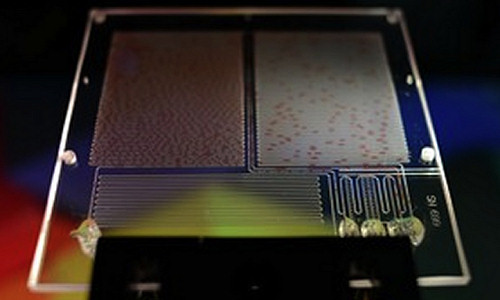Chemical flasks and inconvenient chemostats for cultivation of bacteria are likely soon to be discarded. Researchers from the Institute of Physical Chemistry of the Polish Academy of Sciences in Warsaw were first to construct a microfluidic system allowing for merging, transporting and splitting of microdroplets.
Since now, hundreds of different bacteria cultures can be maintained simultaneously in a single system, which could speed up the research on resistance of bacteria to antibiotics.
We could safely say that without chemical flask there would be no chemistry at all. It has been since years, however, the chemists’ dream to be able to downscale to the microscale the operations that are easily performed with large quantities of chemicals inside flasks, including refilling, mixing, pouring out. The first microfluidic system capable of performing all the typical operations with chemicals inside miniscule droplets has been presented just now. The device, fabricated by a group of researchers from the Institute of Physical Chemistry of the Polish Academy of Sciences (IPC PAS), headed by Dr. Piotr Garstecki, allow for performing strictly controlled chemical reactions and cultivation of bacterial colonies inside multiple microdroplets at a time.
The research paper reporting a system for cultivation of bacteria has just been published in the journal Angewandte Chemie International Edition.
Microfluidic systems are fabricated from polymer plates with sizes resembling a credit card or less. Inside the systems, a carrier fluid (mostly oil) carrying microdroplets containing chemicals flows laminarly through tiny channels of diameters in the range of tenths or hundredths of a millimetre. Using a single microfluidic system, up to a few dozen of thousands of different chemical reactions can be carried out during a day.
Existing microfluidic systems featured a serious drawback: they did not allow to carry out and control long-lasting processes requiring to perform thousands of operations on each of hundreds of microdroplets. Due to this limitation, e.g., long-lasting cultivations of microorganisms were not possible. To provide bacteria with normal growth conditions, they must be supplied with nutrients, and metabolites must be removed from their environment on a regular basis.
“Our microfluidic system allows to add to and to collect from each of hundreds of droplets circulating within the device a precisely measured amount of fluid”, says Dr. Garstecki.
The microsystem from the IPC PAS is composed of two branches of microchannels forming densely arranged zigzags. Up to a few hundred droplets, at a distance of about one centimeter from each other, can circulate in the microchannels. The microdroplets move in a pendular movement from one branch to the other.
“On the way between the branches, the droplets flow through a system of channels, where we can collect a bit of fluid from each droplet – or add a bit of fluid, depending on what is needed. As the only ones, we can do this no matter what is the direction the droplet is moving in, by appropriately changing the flows in intersections of the microchannels”, explains Dr. Sławomir Jakieła (IPC PAS).
Moreover, each droplet circulating within the microfluidic system has its own unique identifier, assigned by the optoelectronic system. It allows the researchers to monitor at any time what operations have been carried out on each microdroplet.
The possibility of cultivation of bacteria in single microdroplets for a time counted in tens and hundreds of hours, requiring multiple nutrient medium replacement, is of paramount practical importance for medicine. It is also related to occurrence of a growing number of drug-resistant strains that begin to appear even outside hospitals. Meanwhile, the search for new, effective antibacterial drugs requires to carry out up to tens of thousands of experiments with antibiotics administered in various concentrations. When performed with traditional methods, these experiments last for a very long time and are extremely expensive.
“The size of typical chemostats for cultivation of and studies on bacteria cultures resembles that of bioreactors of a few liter volume, so that they are large and inconvenient. In addition, they require a quite a number of connections, mixers, and supplies. Removing biofilms forming on the walls is troublesome. All these problems disappear if we cultivate bacteria in our microdroplets”, says Tomasz Kamiński, a PhD student at the IPC PAS.
A single droplet can include up to over one hundred thousand bacteria. The crucial fact here is that the bacteria are not able to move between the droplets. This is impossible because of the laws of physics (the bacteria would have to cross the surface membrane of a microdroplet) and chemistry (carrier liquid used to transport microdroplets is not an environment favourable for the life of bacteria).
“We can transform each our microdroplet in a real bioreactor. Therefore, in a single small plate we can have up to several hundreds of bioreactors, with different, controlled concentration of an antibiotic, a different antibiotic, or even different bacterial species in each bioreactor”, stresses Dr. Garstecki.
The solutions related to the splitting of microdroplets, developed by the researchers from the IPC PAS during construction of the new microsystem, are covered by international patents.
Story Source:
The above story is based on materials provided by Institute of Physical Chemistry of the Polish Academy of Sciences.





